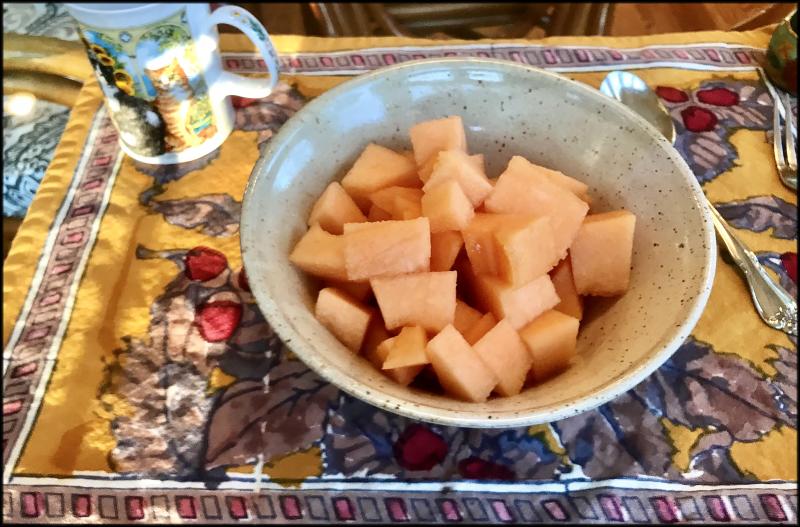Cantaloupe can be enjoyed in any season
One of the benefits of efficient global transportation systems is the almost year-round availability of produce. While nothing is better than locally grown foods sourced from nearby family farms, it can be helpful during the off-season to still be able to find fruits and vegetables associated with the summer months. This week it’s cantaloupe.
Here in Delaware, you’ll see just-picked cantaloupe show up at the farmers markets starting in early July. Through the colder months, you’ll find melons from countries such as Guatemala, Costa Rica, Honduras or Mexico in the supermarket. Supplies from California, Arizona and Texas will begin to find their way to your favorite grocery store starting next month.
The cantaloupe we’re familiar with is a type of muskmelon from the same family as honeydew, casaba and Crenshaw melons. They likely originated in Persia (modern-day Iran) and were cultivated by the ancient Egyptians, Greeks and Romans. Food historians agree that we have Christopher Columbus to thank for the arrival of cantaloupe in the New World, where it was well received because of its sweet, juicy flesh.
For its name, we look to the Italian commune of Cantalupo in the Sabine Hills near Tivoli, a summer residence of the pope, where cantaloupe has been cultivated for centuries. The cultivar Netted Gem was developed by Burpee in 1881 and has been widely grown across America since then. The name reflects the appearance and texture of the cantaloupe rind, which resembles a net.
There are opposing points of view about whether or not cantaloupes can ripen after they’re picked. Watermelons, for example, will not continue to ripen once harvested, and many apply the same rule to cantaloupes. However, non-local cantaloupes that require travel to a distant market are picked mature but not completely ripe to prevent them from damage during transit.
To select a cantaloupe, choose one that is heavy for its size, without bruises or soft spots. Sniff the blossom end to check for its signature fragrance: faint aroma means the melon needs to sit a few days on your countertop to ripen. You’ll know when it’s ready by the deep, musky, sweet fragrance.
Once they’re ripe, keep them in the refrigerator until you’re ready to use them. Also, wrap them in plastic or a kitchen towel to keep them from absorbing odors from other foods. Keep in mind that cantaloupes are grown on vines above ground and are widely handled during picking and processing. To avoid the possibility of transmitting salmonella, be sure to wash the outside rind before cutting the melon.
My favorite way to enjoy cantaloupe is chopped and mixed with cottage cheese, but that’s hardly a recipe. And, the bowl of chopped cantaloupe in the photo is simply a breakfast side dish. If you’d like to combine salt and sweet, wrap thin slices of cantaloupe with paper-thin pieces of prosciutto, always a delicious party appetizer.
A few surprising destinations for cantaloupe include tea bread and soup, the recipes for which are below. The bread uses both baking powder and baking soda to make sure the texture isn’t too dense with all the moisture from the grated fruit. It’s worth taking the extra time to chill the soup before serving, and if you’re not a fan of mint (like me) you can replace it with basil.
Cantaloupe Quick Bread
1 1/2 C flour
1 t cinnamon
1/2 t salt
1/2 t ginger
1/2 t baking powder
1/2 t baking soda
1 C sugar
2 eggs
1/2 C melted butter
1 t vanilla
1 C grated ripe cantaloupe
Preheat oven to 350 F. Coat the inside of a 5-by-8-inch loaf pan with nonstick cooking spray; set aside. Sift dry ingredients together in a large bowl; set aside. In a mixing bowl, beat together sugar, eggs, butter and vanilla until well blended. Stir in the cantaloupe. Fold the wet ingredients into the dry ingredients, mixing just until combined. Pour the batter into the prepared pan and bake until a tester comes out clean, about 1 hour. Allow to cool on a rack before removing loaf from the pan. Yield: 1 loaf.
Cantaloupe Soup
5 C chopped cantaloupe
1/2 C Greek yogurt
1/2 C orange juice
2 T lime juice
2 T lemon juice
2 T honey (optional)
pinch salt
mint sprigs for garnish
Place the cantaloupe in the bowl of a food processor; add yogurt and orange, lime and lemon juices. Pulse to process until smooth. Stir in honey and salt. Refrigerate for at least 30 minutes before serving. To serve, ladle into bowls or stemless glasses and garnish with mint sprigs. Yield: 6 servings.
























































